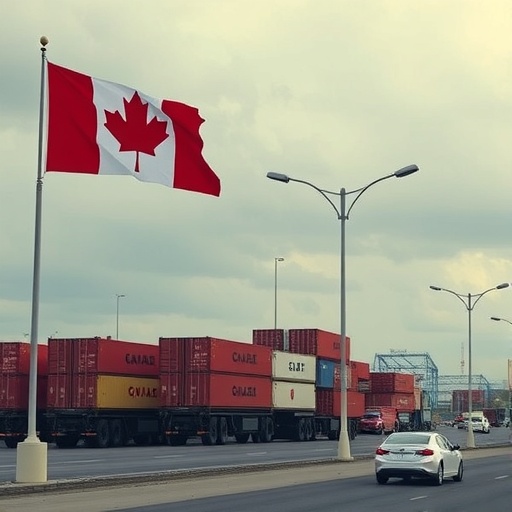Trump Escalates Trade War: 10% Import Tax Threat Looms Over Canada After Ontario’s Anti-Tariff Ad Blitz
In a stunning escalation of cross-border tensions, President Donald Trump has vowed to impose an additional 10% import tax on all goods from Canada, directly targeting the province of Ontario for airing a provocative anti-tariff television advertisement. The announcement, made during a fiery White House press briefing on Tuesday, comes just days after the ad campaign hit airwaves, portraying U.S. tariffs as a direct assault on Canadian livelihoods. This move not only reignites longstanding trade disputes but also risks unraveling the fragile economic ties between the world’s closest neighbors.
Ontario’s Anti-Tariff Ad Ignites Diplomatic Firestorm
The controversy erupted when Ontario‘s provincial government launched a multimillion-dollar advertisement campaign aimed at highlighting the devastating impacts of Trump‘s previous tariff policies. Titled “Tariffs Hurt Us All,” the 30-second spot features everyday Canadians—farmers from rural Ontario, auto workers in Windsor, and families in Toronto—sharing emotional stories of job losses and rising costs attributed to U.S. protectionism. “Why should we pay the price for America’s trade games?” one factory worker laments in the ad, his voice cracking with frustration.
Aired on major networks across Canada and even spilling over into U.S. border states via cable, the advertisement quickly amassed over 5 million views on social media within 48 hours. Ontario Premier Doug Ford defended the campaign, stating in a press conference, “We’re not backing down. This ad tells the truth about how Trump‘s tariffs are squeezing our economy. Ontario exports $100 billion worth of goods to the U.S. annually—mostly cars, machinery, and agricultural products. We can’t let that be undermined.”
Critics in the U.S., however, viewed the ad as a blatant political attack. Conservative commentators on Fox News labeled it “propaganda designed to sway American voters,” while social media erupted with hashtags like #CanadaBait and #TariffTruth. The ad’s timing—mere weeks before midterm elections—added fuel to the fire, with some accusing Ontario of meddling in U.S. domestic politics. According to Nielsen ratings, the spot reached an estimated 12 million viewers in its first week, making it one of the most-watched provincial ads in Canadian history.
Behind the scenes, the advertisement was produced by Toronto-based agency McCann Canada at a cost of $2.5 million, funded through provincial trade promotion budgets. It drew inspiration from similar campaigns during the 2018 USMCA negotiations, where Canada faced steel and aluminum tariffs. Public opinion polls conducted by Angus Reid Institute post-launch showed 68% of Canadians supporting the ad’s message, with 45% believing it would pressure Washington to reconsider trade barriers.
Trump’s Swift Retaliation: Detailing the 10% Import Tax Proposal
President Trump wasted no time responding to the Ontario advertisement. During a rally in Michigan—a state heavily reliant on cross-border auto trade—he thundered, “Canada thinks they can run ads attacking our great American policies? Not on my watch. We’re hitting them with an extra 10% import tax on everything from maple syrup to minivans. Fair trade means no more games!” The crowd erupted in cheers, underscoring the domestic political appeal of his hardline stance.
The proposed import tax, if enacted, would layer atop existing duties under the USMCA agreement, potentially adding $10 billion annually to the cost of Canadian imports. White House economic advisors estimate that key sectors like automotive (which accounts for 40% of U.S.-Canada trade) and energy exports from Alberta pipelines would bear the brunt. Trump cited Section 301 of the Trade Act of 1974 as legal justification, arguing the ad constitutes “unfair trade practices” by influencing U.S. public opinion.
Details from leaked memos obtained by Reuters reveal the import tax would be implemented via executive order, bypassing Congress for speed. Targeted goods include Ontario-specific exports like beer from Molson Coors, furniture from IKEA’s Canadian operations, and even cultural items such as hockey equipment. U.S. Trade Representative Robert Lighthizer echoed Trump‘s sentiments in a statement: “This isn’t retaliation; it’s reciprocity. Canada must respect our sovereignty.”
Economists warn of immediate ripple effects. A report from the Peterson Institute for International Economics projects a 0.5% GDP dip for both nations if the tax proceeds, with U.S. consumers facing higher prices on everything from groceries to gasoline. In Ontario, the auto industry alone employs 120,000 people, and executives from Ford and General Motors have already voiced concerns over supply chain disruptions.
U.S.-Canada Trade History: From Allies to Adversaries
This latest spat is just the latest chapter in a tumultuous trade relationship between the U.S. and Canada. Since Trump‘s first term, tariffs have been a recurring weapon. In 2018, he slapped 25% duties on Canadian steel and 10% on aluminum, prompting Canada to retaliate with $12.6 billion in countermeasures on U.S. products like whiskey and yogurt. The dispute was resolved in the USMCA deal, but lingering resentments persist.
Ontario, as Canada‘s economic powerhouse, has been ground zero for these battles. The province sends 80% of its exports south of the border, fueling $400 billion in annual trade volume. Historical flashpoints include the 1980s softwood lumber wars, where U.S. claims of subsidies led to billions in penalties, and the 2000s dairy disputes that nearly derailed NAFTA.
Experts point to deeper issues. Dr. Laura Dawson, a senior fellow at the Wilson Center, notes, “Trump‘s approach treats Canada as an adversary rather than a partner. The Ontario ad is symptomatic of growing frustration—Canadians feel they’re subsidizing U.S. markets without fair access.” Statistics from Statistics Canada show bilateral trade hit a record $800 billion in 2023, but disputes have eroded trust. A recent Conference Board of Canada survey found 55% of businesses citing tariff uncertainty as their top concern.
Geopolitically, the timing is precarious. With global supply chains strained by the Ukraine war and China tensions, U.S.-Canada cooperation on energy and defense—via NORAD and shared pipelines—could suffer. Former Ambassador David MacNaughton warned in an op-ed, “This import tax threat risks turning allies into rivals, at a time when we need unity most.”
Economic Fallout: Industries Bracing for Tariff Turbulence
The proposed 10% import tax could devastate key sectors on both sides of the border. In Ontario, the agriculture industry—already reeling from past U.S. duties on softwood and beef—fears a double whammy. Ontario Agriculture Minister Lisa Thompson highlighted, “Our farmers export $4 billion in goods to the U.S. yearly. This tax would price us out, leading to farm closures and higher food prices everywhere.”
Auto manufacturing, a linchpin of the relationship, stands to lose the most. The Windsor-Detroit corridor, dubbed the “Automotive Golden Horseshoe,” produces 2.5 million vehicles annually, with parts crisscrossing the border multiple times. A study by the Canadian Vehicle Manufacturers’ Association predicts 50,000 job losses if tariffs rise, echoing the 2018 crisis when GM shuttered its Oshawa plant, idling 2,500 workers.
On the U.S. side, consumers and businesses aren’t immune. Retail giants like Walmart and Home Depot source heavily from Canada, and analysts from Moody’s forecast a 2-3% price hike on imported goods, contributing to inflation pressures. Energy trade, vital for U.S. Midwest refineries, could see costs soar; Canada supplies 60% of U.S. crude imports.
- Automotive Sector: Potential $5 billion in added costs, per Auto Alliance estimates.
- Agriculture: Ontario’s $1.2 billion dairy exports at risk, threatening supply chains.
- Energy: Pipeline flows from Alberta to U.S. Gulf Coast could face delays and surcharges.
Small businesses in border towns like Buffalo, New York, and Sarnia, Ontario, are already feeling the pinch. Local chamber of commerce reports indicate a 15% drop in cross-border tourism since the ad aired, as uncertainty breeds caution.
Canadian Pushback and Global Reactions to the Tariff Threat
Canada‘s federal government has mobilized swiftly against Trump‘s import tax proposal. Prime Minister Justin Trudeau convened an emergency cabinet meeting, vowing, “We won’t be bullied by threats. This ad was about facts, not fiction, and we’ll defend our trade rights through every channel.” Ottawa is preparing a formal complaint to the World Trade Organization, citing violations of USMCA dispute mechanisms.
In Ontario, Premier Ford rallied provincial leaders, announcing a $500 million trade diversification fund to pivot exports toward Europe and Asia. “If Trump wants a fight over our advertisement, we’ll fight smart—by building new markets,” he declared. Bipartisan support in Canada’s Parliament underscores national unity, with opposition leader Pierre Poilievre adding, “Tariffs are a lose-lose; time for cooler heads.”
Internationally, reactions are mixed. The European Union expressed concern over potential spillover effects on global trade, while Mexico—USMCA’s third partner—urged dialogue to avoid a North American trade war. Business lobbies like the U.S. Chamber of Commerce have lobbied against the tax, warning of “unintended economic harm.” A coalition of 200 economists penned an open letter to Trump, stating, “Retaliating against speech with taxes sets a dangerous precedent.”
As negotiations loom, whispers of compromise emerge. Sources close to the State Department suggest backchannel talks could involve softening the ad’s tone in exchange for tariff pauses. However, with Trump‘s base demanding toughness, resolution remains elusive.
Looking ahead, this episode signals deeper fractures in U.S.-Canada relations. If the 10% import tax materializes, it could trigger a cascade of retaliatory measures, from Canadian duties on U.S. tech to joint ventures shifting production overseas. Trade experts predict prolonged uncertainty, urging both sides to prioritize dialogue. As Ontario‘s ad campaign evolves—now with digital extensions targeting swing states—the stakes have never been higher, testing the resilience of one of the world’s most integrated economies. Stakeholders on both borders watch anxiously, hoping for de-escalation before lines harden into walls.










